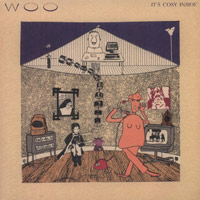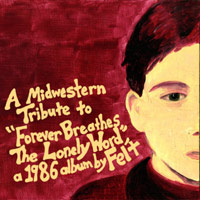
The Bears for Lunch
GBV Inc.
With the band having made countless albums over the course of its nearly 30-year existence, the question that each Guided By Voices album must now answer is much more philosophical than merely thumbs up or thumbs down. Indeed, with GBV ringleader Robert Pollard having spearheaded the creation of five records just this year—three with the now seemingly fully employed “classic” GBV line-up—any album with which he is involved must in some way justify its existence. It is no longer enough for any collection of songs to just add to the accumulated detritus of Uncle Bob. Instead, they must somehow transcend their etched grooves to enter—or at least approach—the exalted realm where the band’s best work resides.
As has become more obvious with each subsequent release (and is clearly evident in recent setlists), Pollard and his Dayton mates are up to the challenge. The Bears for Lunch shows the kind of songwriting ingenuity that characterized the band’s best work from the ’90s, as well as the sort of wondrous eclecticism found on those same records. Pollard himself careens between the rugged riffs and dive bar mysticism of “Hangover Child,” the frayed starkness of “Tree Fly Jet” and the soaring hooks of “She Lives in an Airport.” But Tobin Sprout also contributes a handful of songs, and his pastoral pop-folk stands (as it has often in the past) as the perfect, delicate counterpoint to Pollard’s propensity to rock. “The Corners Are Glowing” sounds likes some long lost Olivia Tremor Control gem, while “Waving at Airplanes” (air travel is a dominant theme on the lp) is pure spun gold. If there was any question as to GBV’s raison d’etre, The Bears for Lunch answers it with 19 clear examples of the band’s vitality.
Stephen Slaybaugh

Cobra Juicy
Rad Cult
The cliche goes, “Don’t judge a book by its cover,” but when a band is named Black Moth Super Rainbow and the lead singer goes by the name of Tobacco and other band members feature such monikers as Father Hummingbird, Bullsmear and The Seven Field of Aphelion, it’s pretty safe to say that the experience will be slightly skewed. Add in a fondness for wearing masks and the fact that very little concrete biographical information is known about the band, approaching Black Moth Super Rainbow and its catalog is like going blindfolded into a fun house.
In a similarly confusing fashion, it is unclearly whether Cobra Juicy, the latest Black Moth Super Rainbow release, is the work of the full band or if it’s just Tobacco in Billy Corrigan mode. Regardless of the methodology, it reveals the same fusing of folk, psychedelic rock, electronic music and hip-hop as past releases, but with an unexpected twist. Dandelion Gum, Black Moth’s 2007 breakthrough, contained the DNA for every excursion the band could take. That album covered such a broad stylistic swath that afterwards nothing could really be a surprise. Yet, Cobra Juicy will catch anyone familiar with the band off-guard. The aforementioned patchwork melding of styles is largely abandoned, leaving a streamlined synth pop album in its stead.
As such, while there are weird flourishes here and there, there are large portions of the album that wouldn’t sound out of place on a Kylie Minogue album. To be fair, Tobacco has always performed his vocals through a vocoder so perhaps the direction of Cobra Juicy was inevitable. And while the record isn’t as wild of a ride as past records, there’s a certain charm in hearing the Black Moth style crammed into capsule-sized pop songs. Songs like “Blurring My Day” and “Spraypaint” hit hard, but at other times the record meanders. With the vocals buried, the record isn’t as engaging as it could be. Still, Cobra Juicy is an interesting wrinkle in the band’s freak flag.
Dorian S. Ham

It’s Cosy Inside
Drag City
It’s Cosy Inside is a 1989 work from British brother’s Mark and Clive Ives recently put back into print. Unlike most records of this ilk, which are well-known in small circles as cult relics before being thrust upon a new audience, there are virtually zero recollections or true champions of Woo’s one recorded anomaly. It was only Ramona Gonzales of Nite Jewel, who insised that this record “changed her life,” that prompted Drag City to get on board a ride few had ever known.
At heart, It’s Cosy Inside is a timeless piece of new-aged psychedelia that really has no rhyme or reason or straight path that it follows. The Ives brothers constructed the album using acoustic guitars, treated violins and clarinets, various electronics, and distant voices. It may not sound like much—and it’s really not—but under the surface of these minimal and quiet instrumental exercises is the existence of two untrained geniuses operating in a plane of lo-fidelity. The songs on It’s Cosy Inside come in miniature doses (few run beyond two minutes), but each one exhibits its own private universe of mood and texture. Though it seems the brothers were heavily influenced by Eastern mysticism and synthesized experimentation, their sound is hard to define. They perform in a “blink and miss it” sort of vibe, but with repeat listens the record is strangely hypnotic as a whole. Their muses tend to play in opposite directions. “Upside Down,” for instance, displays distorted folk blues on one side and wobbly synth volleys on the other. It’s a peculiar spectrum which seems to always find a calming equilibrium. Throughout they challenge many tropes and often pit these poles against each other. “Downtown Suburbia” takes the doped ambience of Tangerine Dream against the urbane Kraut high jinx of Faust. Pastoral jazz conducted in Stockhausen’s laboratory or Kraftwerk moonlighting with beat poets and bongo drums—both have weight in Woo’s crystalline woodshed.
It’s Cosy Inside is timeless because it’s continually hard to tell exactly when it was conceived. Was it piled and collected for decades or is it the result of one late night epiphany? Though it often recalls the tradition and free-form fractures of the ’60s and ’70s, something as thrilling as the propulsive “No More Telly” confirms the Ives brothers were eyeing the future more than anything else.
Kevin J. Elliott

The Crossing
Dunham
First, it’s worth noting that the Menahan Street Band is Charles Bradley’s backing band, and there are familiar sounds here that have popped up behind Bradley, as well as some melodies that sound straight out of the Budos Band’s repertoire (mainly because Mike Deller plays piano in such instances). But there are also some weird sounds that set this group apart from either of those Daptone standards. The band had a track on the Daptone Gold compilation from a few years back that didn’t exactly fit in with the rest of the record. It wasn’t so much that they stuck out like a sore thumb, but rather the dark mood that surrounds their chosen tone set them apart from the more joyful verve of their labelmates.
There is a similar sweaty, dead-end timbre at work on The Crossing. Imagine this record as the instrumental soundtrack for an after-hours club. In this dank room, there are a few guys in vests and jazzbo hats in the corner, paying no nevermind mind to anyone else, riffing to the perfectly tuned bass drum. It’s like the cover of the first Camp-Lo record, but dumped in a time machine and sent to the 1930s, tasked with inventing fuzz fusion. “Every Day a Dream” trips along a psychedelic path, then falls into the echo-laden acoustic guitar of “Seven Is the Wind,” which pushes the record into the classic rock direction. Most of these cuts sound like sample source material for, say, an early Wu Tang production. All in all, The Crossing is aptly titled, with the Menahan Street Band walking over that bridge between the throwback soul with which they’re usually associated and the weirder, psyched-out Nuggets grooves you might suspect populates the band members’ record collections.
Michael P. O’Shaughnessy

A Midwestern Tribute to “Forever Breathes the Lonely Word,”a 1986 album by Felt
Flannelgraph
If I wanted to be an old crank, I might use this space to complain about how the kids these days have it easy. See, it used to be that if you wanted to hear a band like Felt, you had to seek their records out (especially growing up in the Midwest) and more than likely pay some high import prices to obtain them. But while I agree with what Pere Ubu frontman David Thomas once told me about how one values music more when you put some effort into obtaining it and pay something for it, I also don’t care that anyone discovering Felt these days is probably doing so via the internet. Let them eat their cake and have it too (or something like that).
In an almost reflexive manner, this new tribute to the British band and, specifically, its sixth album from 1986, Forever Breathes the Lonely Word, has garnered my own appreciation for most of the bands covering the record’s eight songs. Tribute records are rarely very good, but this one proves the exception. Pop Zeus leads the album off with a version of “Rain of Crystal Spires” that approximates the original’s pop bent, but interjects a good deal of verve. No Coast does the same for “Down But Not Yet Out,” adding a good deal of distorted jangle that works particularly well for being reminiscent of Felt’s contemporaries. In both instances, Lawrence’s flat delivery is hinted at without being mimicked. Most of the acts here shy from replicating Martin Duffy’s organ work, but it it’s not missed. Though the album falters eventually (the last three cuts aren’t up to snuff), it’s a show of appreciation worthy of its own praise.
Stephen Slaybaugh
ALBUM REVIEWS
The Luyas, Animator
King Dude, Burning Daylight
Blueprint, Deleted Scenes
Cemeteries, The Wilderness
Ty Segall, Twins
Tame Impala, Lonerism
Moon Duo, Circles
AC Newman, Shut Down the Streets
Beth Orton, Sugaring Season
John Cale, Shifty Adventures in Nookie Wood
The Vaccines, Come of Age
Band of Horses, Mirage Rock
Fac. Dance 02: Factory Records 12" Mixes & Rarities 1980-1987
Van Morrison, Born to Sing
